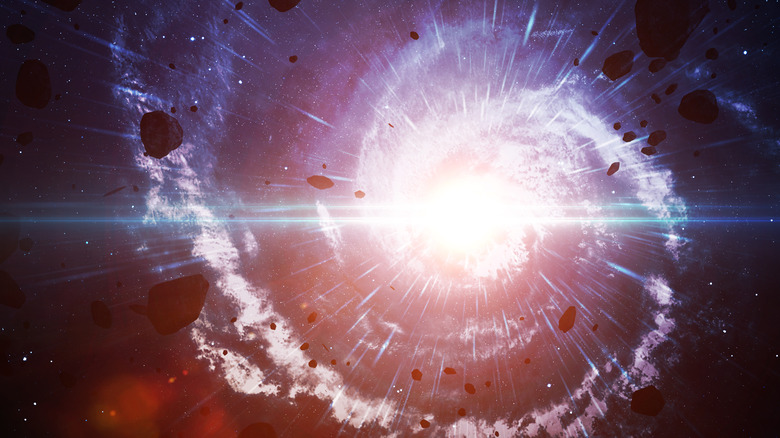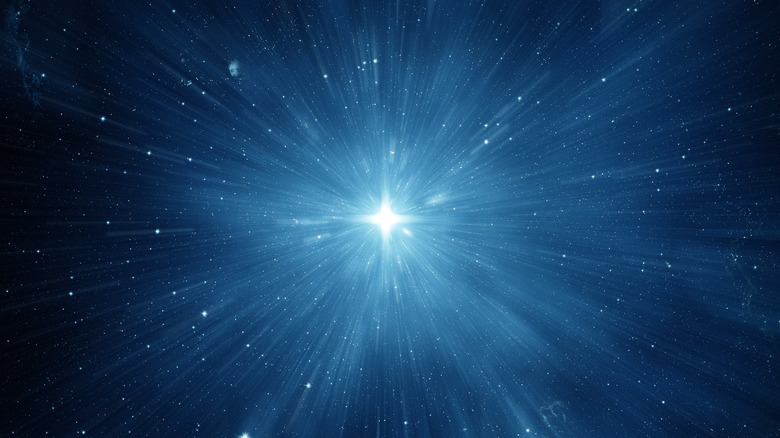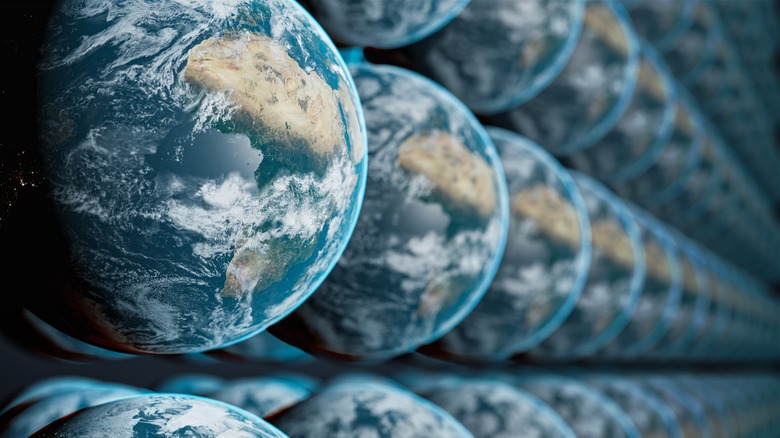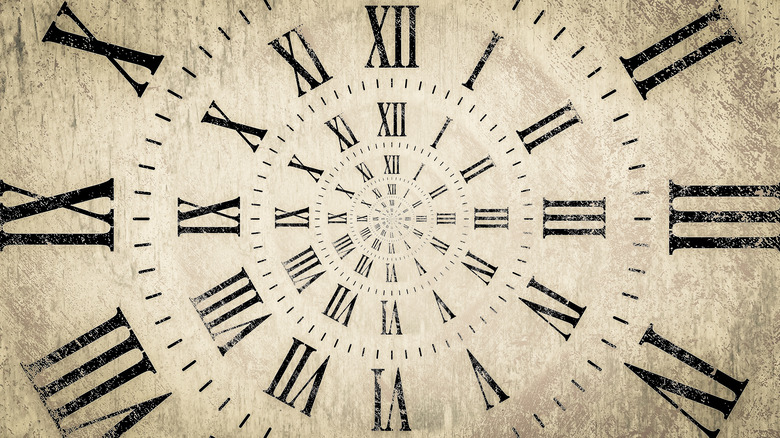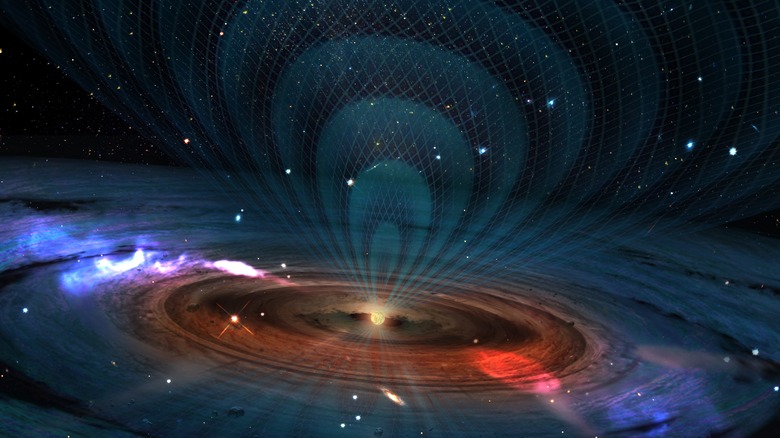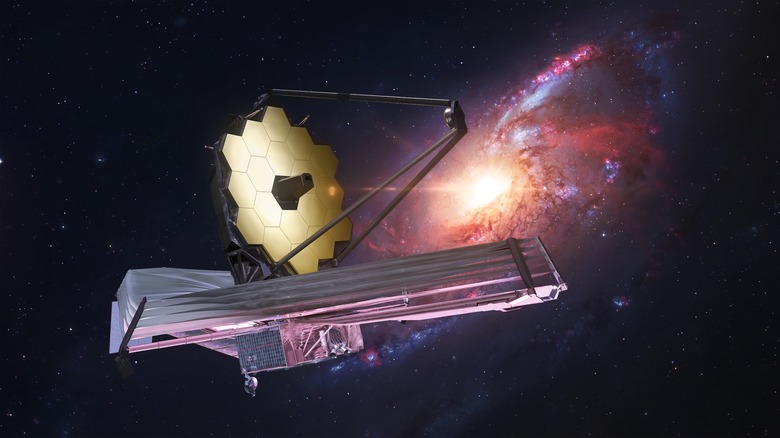What Scientists Think The Universe Was Like Before The Big Bang
The Big Bang is generally considered by physicists to be the starting point of our universe. In a flash of intense heat and light, the beginning of everything that has ever existed in the universe came into being. But is it possible that something could have existed before the Big Bang? After all, something couldn't have come from nothing, right? It turns out the answer is a bit complicated.
Currently, scientists don't know what the universe was like at any point before one second after the Big Bang (via Live Science). At that point, things were cooled enough that quarks and electrons, the building blocks of all matter, came to be. According to the European Council for Nuclear Research, just a few minutes later, protons and neutrons combined, creating the nuclei of the first atoms. From that point, the universe continued to expand rapidly, eventually leading to the creation of the first stars and galaxies. The moments that happened before all of this, however, are still a mystery to physicists. There are several theories that have been suggested over the years to try and explain what may have happened before the Big Bang, although none have been proven — yet.
Theoretical physicists believe our universe could end in a Big Crunch
Before we figure out what happened before the beginning, it is important to know how physicists think it will end. One theory for how our universe will end is known as the Big Crunch. This theory, based on Einstein's Theory of General Relativity, states that our universe's current expansion will eventually slow to a halt. When this happens, the universe will fall in on itself due to gravity (via Universe Today). This will cause all matter to smash together in an event that is essentially the opposite of the Big Bang.
While the Big Crunch isn't the only theory for how the universe will end, it just might be the key to figuring out what might have taken place before the Big Bang. Some scientists have theorized that if the Big Crunch were to occur, it is possible that all that matter being smashed into one place could create enough energy to trigger a second Big Bang, restarting the universe from scratch (via Space.com). If it's possible for the Big Crunch to take place in the future, whose to say one hasn't already occurred and we are currently existing in the second, third, fourth, or even millionth generation of our universe? What if our universe is just constantly bouncing back and forth between the next Big Bang and Big Crunch?
The multiverse theory may provide alternative answers
The idea that we are bouncing back and forth between bangs and crunches is not the only theory that could explain what took place before the Big Bang. For example, theoretical physicist Sean Carroll at the California Institute of Technology and his colleague Jennifer Chen have created their own theory for what may have occurred before our universe. Their paper on the subject, published in 2004, suggested that our universe could have been created as a result of a piece of space-time splitting from a parent universe (via Cornell University).
According to Carroll, this theory works similarly to how radioactive particles decay. Just as a radioactive particle sends out alpha and beta particles as it decays, a parent universe could do the same thing, but sending out Big Bangs that create new universes instead of particles (via Live Science). He believes this process could happen indefinitely, with universes continually creating parallel universes eternally. The idea that we are living in a multiverse has been played around with by others before, but Carroll and Chen's research has helped to lay the foundation of how the multiverse could actually exist.
Steven Hawking believed that events before the Big Bang are unmeasurable
Generally speaking, most physicists don't look much into what happened before the Big Bang. Why? Because for most research, it doesn't really matter. While it is certainly possible that something existed before the Big Bang, it most likely wasn't as interesting as we might think. According to Live Science, it is possible that all that existed before the Big Bang was just dense, hot material that randomly exploded into our universe, but there isn't much we can do with that. For physicists like the late Steven Hawking, studying the moments immediately after the Big Bang are much more important for understanding physics.
According to Hawking, time did not exist before the Big Bang, so there wasn't a before. This can be a hard topic for people to grasp, as we normally think of the progression of time as an important part of how events play out. Simply put, there wasn't a progression of time until the Big Bang. As Hawking put it in a 2018 "Star Talk" interview, "since events before the Big Bang have no observational consequences, one may as well cut them out of the theory and say that time began at the Big Bang" (via the Daily Mail).
Experimental evidence may help us understand the first second of the Big Bang
Unfortunately for the field of physics, there isn't much we can do right now to discover what happened in the milliseconds immediately following the Big Bang. This is because our current technology only lets us see so far back into the early universe. Our universe is currently around 13.8 billion years old (via New Scientist). Even with impressive current technology, the furthest the Hubble Space Telescope was able to see was an object 12.9 billion light years away. According to NASA, the object, nicknamed Earendel, was seen by Hubble as it looked when the universe was only 7% of its current age. That range has been improved with the capabilities of the James Webb space telescope, which (per Time) can see 13.6 billion light years.
The good news is, the detection of gravitational waves in 2015 may be able to pave the way in helping physicists study how the universe may have acted in the moments following the Big Bang. The author of the 2015 study, Stephen Feeney, believes that his findings could help answer questions about the early universe as quickly as within the next few years (via Live Science). These answers could be crucial in discovering how the Big Bang came to be in the first place.
New technology could reveal more information about the early universe
In addition to new discoveries like gravitational waves, newer technology will also be able to help scientists get a better idea of how things may have worked during the first moments of our universe. According to NASA, the James Webb telescope, launched December 25, 2021 (per Space.com), will be able to see as far back as just 100 million to 250 million years after the Big Bang.
While the James Webb Space Telescope has been sending back exciting images — NASA's Goddard Space Flight Center has numerous examples posted online — it may take several years before we can expect to see it make any major discoveries regarding the Big Bang. In the meantime, theoretical physicists will continue to study the complex math surrounding those crucial first moments in order to better our understanding of how our universe was created, and what may have been around before it.
